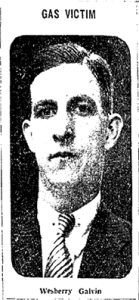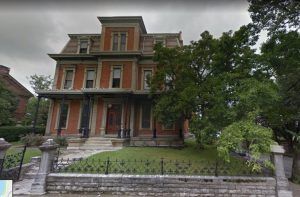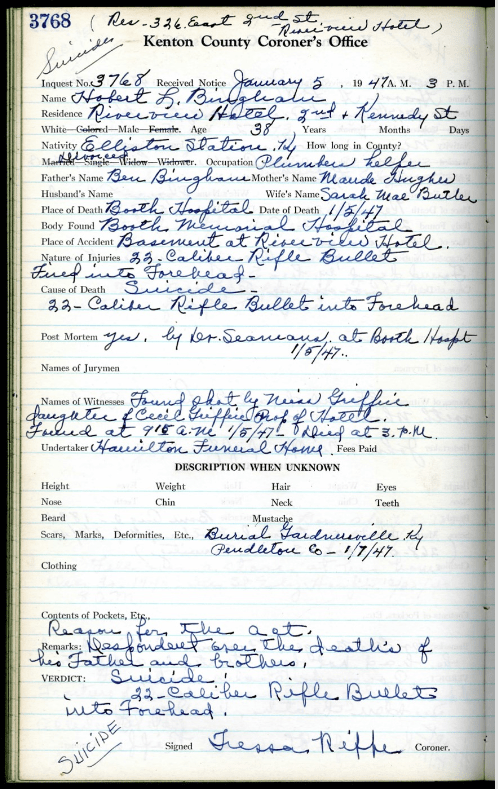Staff of the Local History & Genealogy Department conducted a tour a few years ago entitled Scandals & Mayhem. This tour featured some of the more infamous stories of Covington residents. The following are the notes from the history staff who led the tour that you can follow if you would like to do your own tour. To learn more about future history programs and events, call (859) 962-4070, email history@kentonlibrary.org or visit the events link on the website at kentonlibrary.org.
Warning! This tour will discuss adult content including murder, suicide, and scandals!
Licking Riverside Neighborhood
Licking Riverside Historic District boundaries are Fourth Street to the north, Scott Street, Eighth Street to the south, and the Licking River. Bungalow/Craftsman, Second Empire, and Italianate are the primary architectural styles of the district.
The City of Covington was founded in 1815 with 6th Street as the southern boundary. The area was largely undeveloped until the 1840s. The first major building, which still stands today on Sanford Street, was built by Reverend William Orr for his Female Academy.
In the 1850s, we begin to see prominent Covington residents constructing large family homes on Greenup. The area along the Licking River and Garrard is developed by Jonathan Hearne in the 1870s with homes being built through the early 1900s. Then by the dawn of the 20th Century the multifamily homes and apartment buildings become new additions to the neighborhood.
The neighborhood officially becomes part of the National Register of Historic Places in August 1975. Other prominent houses in this district include the Ernst House and the Grant House. This neighborhood also includes the Baker Hunt Art Academy, LaSalette Academy, and First United Methodist Church.
Hearne House - 5th and Garrard Streets
The Hearn house is a two and one-half story, red-brick home constructed in 1874. It is a Georgian style home. The home was built for Jonathan David Hearne. Hearn was a successful businessman who moved to Covington around 1861. 
In the 1960’s a bridge over the Licking River at Fifth Street was proposed by the Northern Kentucky Area Planning Commission. By 1973, controversial meetings were held by the Highway Department to construct a 5th Street Bridge between Covington and Newport. The plans called for the demolition of the Hearn House. Newport was in support of the bridge, and Covington was deeply divided.
Residents of the neighborhood were deeply opposed to the demolition of the Hearne House. To combat the demolition of the 100-year-old home in 1974 neighborhood residents listed the Hearne House in the National Register of Historic Places. In 1975, the Licking Riverside Neighborhood was listed on the National Register of historic places. By listing the neighborhood, residents could argue that the proposed bridge would destroy the historic character of the entire neighborhood.
A small group of business owners in Covington and interested parties in Newport were in favor of the Hearne House being demolished. Traffic studies were conducted that said that moving the bridge to 5th street would enhance traffic flow and spur economic development between the neighboring cities. Luckily, the bridge never became a reality.
Mr. Wesberry Galvin – Suicide by carbon monoxide poisoning, 425 Garrard Street


In the early morning hours of April 26, 1938, L.M. Highhouse and William Crumbley were walking down Sanford Alley when they noticed smoke leaking out of the closed garage behind 425 Garrard Street. They broke open the garage doors and to find Wesberry Galvin - the 32-year-old son of Maurice L. Galvin, a prominent attorney and Republican leader in Kentucky, in the back seat of the running car. They notified the police and Life Squad, and he was taken to St. Elizabeth, but he was dead on arrival.
His father had been on a business trip to Louisville, but his stepmother was in the house at the time of his death. Wesberry was a control operator for the WCKY radio station, which was owned by his uncle L.B. Wilson, and had ended his shift at 1:00 am, according to friends. According to his friends, Wesberry had been in good spirits in the weeks leading up to his death. He was fond of bird dogs and kept a kennel on his father’s farm on Shaw Road in Independence.
Several months later in November his estate was settled in Kenton County and was valued at $3,125 ($56,282 - 2018 value).
4th Street Bridge – Dr. John Mackoy Leaped into Eternity
 On Thursday, November 5, 1885, Dr. John Mackoy Jr. committed suicide by jumping from the Covington and Newport Bridge into the Licking River. He committed the deed while under a temporary fit of insanity brought on by excessive use of alcoholic drinks.
On Thursday, November 5, 1885, Dr. John Mackoy Jr. committed suicide by jumping from the Covington and Newport Bridge into the Licking River. He committed the deed while under a temporary fit of insanity brought on by excessive use of alcoholic drinks.
The death of his mother Elizabeth two years before his suicide weighed heavily on Dr. Mackoy. Elizabeth died from a fall down the stairs at their home at 907 Madison Avenue. Town gossip ran wild, and rumors swirled that Dr. Mackoy had pushed her down the stairs to her death in a drunken fit. Gossip was that she had to have been pushed and suffered a fractured skull on the way down the stairs.
Witnesses to his leap, stated that he looked nervous and excited as he walked toward the bridge. He went out on to the bridge without paying his toll. He walked to the middle of the bridge, took of his coat, mounted the railing and leaped. He struck one of the telephone-wires on the way down, which caused him to turn wildly before he reached the water. His body never rose to the surface. In fact, his body was never found, and his grave remains empty at Linden Grove Cemetery.
Drawing from the Cincinnati Enquirer, November 6, 1885.
We have several papers and documents related to the Mackoy family in our GeNKY database. We also have Mackoy family photographs in our Faces and Places online collection.
Governors Point Neighborhood - Garrard and Park Place (Alley)
The act incorporating the town of Covington was signed into law by Governor Isaac Shelby on February 8, 1815. Land sale of lots began in the month following and the first official plot, marking many of the same property lines if not buildings that we will talk about today on the northern part of this tour, were filed in the Campbell County Courthouse in August of that year.
Covington’s rapid growth led to its official status as a city by 1834 and the first city council election occurred that same year. Mortimer Benton served as the city’s first mayor, and the council proceeded to divide the growing area into wards in addition to naming the streets in honor of the Governors of Kentucky. Shelby, Garrard, Greenup, Scott, and Madison are all a testament to that time.
Some of this early neighborhood is also referred to as The Point or Governor’s Point. Houses range in age from the mid-1800s to the early 1900s. Prominent houses include the Carneal House, Shinkle Mansion (later the site of Booth Memorial Hospital), the Graziani House, Dabney House, Uriah Shinkle House, and the Louise Southgate House, among many others.
Mrs. Esther Traylor – Suicide by poisoning at 225 Garrard Street

Esther Traylor (nee Bivin) was born around Lexington, KY to Thomas O. and Augusta Bivin in 1905. She lived at 225 Garrard Street.
She was an employee of the Gibson Hotel on Jackson Street in Cincinnati. On July 7, 1934, a bartender of the hotel, Mr. Hugh Meyers, age 31, escorted her home. Upon arriving home, she went into her kitchen, came out a few minutes later, laughed, and remarked “I’ve taken poison.” Mr. Meyers said that he laughed also, after which Esther said, “I’ll show you.” She went into the kitchen again, returned with another bottle and drank the remainder of its contents before Mr. Meyers had time to stop her.
He called the police, and as she was being taken into St. Elizabeth Hospital, collapsed and died as a result of the poison. According to the coroner’s report, Esther drank Lysol and Fowler’s Solution of Arsenic.
She left behind her husband, Joseph H. Traylor, and a 10-year-old son Joseph H., Jr., who lived with her parents in Lexington. She was buried in Lexington Cemetery in Lexington, KY, and her headstone reads: “Our Darling Esther Mae Bivin Traylor.”
Thomas Conry - 202 Garrard Street

Thomas Conry, resident of 202 Garrard Street, was found dead a little bit after midnight on January 1, 1943, at his Liquor Store at 417 Pike Street. He was 73 years old.
Conry had been shot in the neck. He was discovered around 12:30 AM by William C. Devere, a guard at the Covington Filtration Plant in Fort Thomas. He was in Covington looking for two men who failed to show up for work. (They were probably out drinking on New Years Eve.)
The robbers failed to take any money from Conry’s store. There was still $100 in the cash register and additional money hidden elsewhere in the store was accounted for by police.
For several months the case went unsolved until 15-year-old Clara Minch came forward. Clara was the young wife of 20-year-old Oliver Minch. Clara confessed to authorities that her and Oliver had entered the store on New Years Eve. Her husband became enraged when he thought Thomas Conry was flirting with his wife. He demanded money from Conry, who refused, and Minch shot him.
Oliver Minch pled guilty to the murder of Thomas Conry as well as four other indictments. The other four consisted of two for armed robbery, and two for automobile thefts. He was sentenced to life in prison. He served only 12 years in Eddyville Penitentiary before he was released on parole. For unknown reasons he returned to Eddyville prison, and he died there at the age of 47 of cancer.
Clara Minch was charged with being an accessory before and after the fact of murder. She also was held under a charge of delinquency. Charges were eventually dropped against her.
Booth Hospital – Shinkle Mansion


93-Year-Old Peter Shinkle caused quite the scandal in 1883. How does a 93-year-old man cause quite a stir you ask? Peter Shinkle decided to marry Martha Bedgood, a woman 43 years his junior! To understand this scandal, you need to know more about the Shinkle family.
Peter Shinkle was born in Brown County, Ohio around 1795. In 1813 at the age of 18 he married Sarah “Sally” Day in Clermont County, Ohio. They had at least six known children. The family moved to Covington around 1847. Peter and Sarah’s son Amos, was the most prosperous of the children. Amos made a lot of his fortune in the coal, and steamboat business. His father and brothers were not as successful in business, but they remained a strong and close family. In the 1860s Amos bought a property at the corner of 2nd and Kennedy and constructed a large Gothic Revival Mansion. The mansion was torn down in the 1920s to create the present Boothe Memorial Hospital. The building is now luxury condos.
Sarah Shinkle died in 1874. Almost seven years later, Peter Shinkle meets Martha Bedgoode, a widow, who is 43 years younger than Peter. Amos and his siblings do not approve of the match. In fact, they conspire against the couple by bribing the local county clerks to not issue a couple a marriage license. Peter and Martha decide to board a train for Louisville and get married there on April 2, 1882.
Amos and his siblings are livid, and because Peter had been living with Amos and working for Amos for the last several decades, Amos decides to kick his father out of his house. Peter in retaliation decides to sue his son Amos for back wages for working for Amos without pay from 1849-1883.
A judgment was settled between Amos and his father Peter in which was due $18,840. Amos had only paid his father $2,111 by the time Peter died in November of 1886. Peter had only been married for 4 years when Peter died. Martha became the executrix of his estate, and for two years demanded in court the $16,729 be paid immediately to the estate by Amos. The newspapers referred to Martha as Amos’s mother. Which I’m sure insulted and angered Amos Shinkle. Martha was 15 years younger than him!
Grey Lady Urban Legend - Carneal House

The Carneal House is the oldest historic residence in Covington, located at 405 E. 2nd Street. Thomas D. Carneal built the sprawling structure in 1815, the same year the city of Covington was founded. The home is a two story and built in the Italianate-Federalist Style. The rear wing was added in 1835, and the home has been remodeled numerous times since.
The “Lady in Grey” is said to haunt the Carneal Estate. Popular legend states that a young lady committed suicide on the property after being rejected for a dance with the visiting Marquis de Lafayette.
This story sounds spooky, and romantic, but it’s actually just a historically inaccurate urban legend. The Marquis de Lafayette did visit Kentucky between 1824-1825. William Wright Southgate and his family were living in the house at the time of his visit. However, historians believe that Lafayette did not visit this house, in fact, he may have never come to Covington at all! He actually visited the home of William Southgate’s wife Mrs. Adelizza Keen Southgate in Lexington!
Mr. Hobert L. Bingham – Suicide at the Riverview Hotel
 We know this house as the Graziani House. It was built in French Victorian style by Howell Lewis Lovell of the Lovell & Buffington Tobacco Company, whose factory once sat on the 200 block of Scott Boulevard (where the parking garage is today).
We know this house as the Graziani House. It was built in French Victorian style by Howell Lewis Lovell of the Lovell & Buffington Tobacco Company, whose factory once sat on the 200 block of Scott Boulevard (where the parking garage is today).
Benjamin F. Graziani, a prominent Covington attorney in the late 19th and 20th centuries, who lived in this house until the early 1900s. It later became the Riverview Hotel, where Mr. Hobert L. Bingham, a 39-year-old divorced man who worked as a helper to a plumber, resided. On January 5, 1947, Mr. Hobert was found in the basement of the Riverview Hotel by Mary Jane Griffin, daughter of the hotel owner, when he did not show up for breakfast that Sunday morning. He had shot himself in the forehead with a .22 caliber rifle, though the shot did not end his life. He was still alive when Ms. Griffin found him, and he was taken by the Life Squad to Booth Hospital, where he died several hours later at 3:00 pm.
According to the coroner, he had a phone conversation with his mother, Mrs. Maude Bingham, around 11:00 pm the night before. The coroner, Dr. Riffe, inferred that Mr. Bingham was despondent over the death of his father and brothers. His father had died of a heart attack just a few months prior in September of 1946; his oldest brother William died in 1944 of pulmonary tuberculosis; and his youngest brother Ernest died while serving in WWII in 1942.
As if three deaths in the family were not tragic enough, Hobert’s mother Maude passed away just a year and a half later (in May of 1948) of thyroid cancer. In a span of 6 years, this family lost 5 loved ones. Mr. Bingham was buried in his native Grant County, KY in Gardnersville Cemetery.
We found Hobert L. Bingham in the Kenton County Coroner Inquest Records in GeNKY.




Add a comment to: Historic Tour Recounts Covington’s Scandals & Mayhem